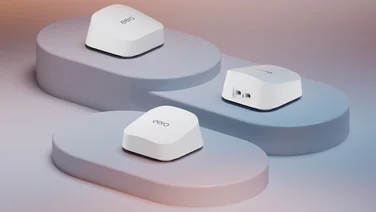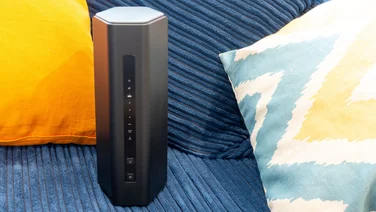To help us provide you with free impartial advice, we may earn a commission if you buy through links on our site. Learn more

- Extends to dead spots well
- Slower than an ethernet cable
- Unintuitive interface
While wireless mesh networks can improve the signal throughout your home, they’re typically only any good if you have a decent Wi-Fi or Ethernet connection between the wireless satellites. The Devolo Magic 2 WiFi is designed to be different, using Powerline networking to connect the Wi-Fi satellites around your home, producing, in theory, a more stable connection.
READ NEXT: Best wireless router
Devolo Magic 2 WiFi review: Price and features
The Devolo Magic 2 WiFi is available in two kits. Both have a single Powerline adaptor with a single Ethernet port that plugs into your home router. The difference is that the Starter Kit (£161) has a single Wi-Fi adaptor, while the Whole Home kit (£263) has two Wi-Fi adaptors to give you greater coverage. Both kits work in the same way; it’s merely a question of how much coverage you want.
All kits come pre-paired, so you just need to plug in the adaptors and you should be good to go. We say ‘should’, as it’s important to connect the adaptors in the right order: start with the wireless adaptors first, then plug in the Powerline adaptor that connects to your router. If you don’t, you can end up with an adaptor that doesn’t work, as we found out. Once all the lights on all the adaptors are white, the network is ready and you’re good to go.
On the back of the wireless adaptors, you get a wireless key, which is the default password for the wireless network. If you’ve bought a kit, then you get two different passwords, which is a touch confusing. The system takes the password from the main device, which would appear to be the adaptor that you plug in first, although the quick start guide isn’t clear on this. Luckily, we managed to enter the correct password the first time around, purely by luck.
Devolo Magic 2 WiFi review: Performance
Once you’ve got the Magic 2 running, you’re supposed to be able to manage it using the smartphone app or the Devolo Cockpit software for Windows or Mac. We found that on our iPhone, the software wouldn’t discover any of the Powerline adaptors. Switching to the Mac version, we discovered one adaptor but not all three, which was strange, as they were all definitely working and connected.

In the end, the easiest option was to connect directly to each adaptor’s IP address using a web browser. To get the IP addresses, we had to connect to our router and look at the list of connected devices for any Devolo products.
The device you connect to defines the options available. Connect to the standard Powerline adaptor and you don’t get any wireless options. If you want to adjust the wireless settings, you have to connect to one of the wireless adaptors; it doesn’t matter which.
For some reason, selecting the Wireless option in the web management page automatically jumps you to the Guest network, rather than the main settings. That’s a little confusing, as is the fact that Devolo calls the wireless password ‘Key’ under the guest network settings and ‘Encryption’ under the main network settings.
Under the main wireless network settings, you can change the name of the network and the password, and you can manually change the wireless channels used by both the 2.4GHz and 5GHz networks. Changes made to any wireless adaptor are changed on all of them.
As with other mesh systems, Devolo uses roaming to push devices to the strongest wireless adaptor and band steering to direct incoming devices to the best network. There’s an option to schedule when the entire Wi-Fi network is available but you miss out on some of the more advanced features, such as user profiles for advanced parental controls.
The Powerline network runs at up to 2,400Mbit/s, but your wiring will affect that. Testing with a laptop plugged into a wireless adaptor’s Gigabit Ethernet, we saw upload speeds of 47Mbit/s and download speeds of 72Mbit/s. That’s fine for streaming video, but far slower than using an Ethernet cable.
The Magic 2 has 5GHz speeds of 867Mbit/s with two streams, and 2.4GHz speeds of 300Mbit/s with two streams. Again, it’s worth pointing out that the final speed limit will be limited by the overall speed of the Powerline network to your router. In our home, the best we managed to get was upload speeds of 44Mbit/s and download speeds of 73Mbit/s.
Plugging the Magic 2 adaptors into the same ring main, we saw slightly improved results of 78.3Mbit/s upload and 97.4Mbit/s download, so the quality of wiring makes a difference.
READ NEXT: Best powerline adapter
Devolo Magic 2 WiFi review: Verdict
If you need to push Wi-Fi out to a dead spot, the Devolo Magic 2 will do the job, but a conventional mesh system will be better for most people. For similar money as the Starter Kit, you can get the Netgear Orbi RBK20, which is faster, and has both parental controls and optional network security. For the cost of the Magic 2 Whole Home kit, the Netgear Orbi RBK50 is even more powerful.






